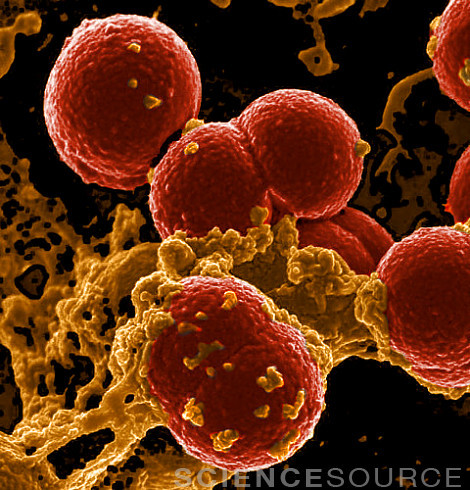#pathogens
Image JC3202 (Neutrophil Ingesting MRSA Bacteria)
Colorized scanning electron micrograph of Neutrophil white blood cells (light orange) ingesting Methicillin-Resistant Staphylococcus Aureus bacteria (deep red).
Methicillin-Resistant Staphylococcus Aureus (MRSA), also called multidrug-resistant staphylococcus aureus and oxacillin-resistant staphylococcus aureus (ORSA). This bacterium is responsible for several difficult-to-treat infections in humans.
MRSA is any strain of Staphylococcus aureus that has developed resistance to beta-lactam antibiotics, like penicillins and cephalosporins. Strains unable to resist these antibiotics are classified as methicillin-sensitive Staphylococcus aureus, or MSSA.
MRSA is especially troublesome in hospitals and nursing homes, where patients with open wounds, invasive devices, and weakened immune systems are at greater risk of infection than the general public. If not treated quickly, MRSA infections can cause sepsis and death.
It is usually spread by direct contact with an infected wound or from contaminated hands, usually those of healthcare providers. Also, people who carry MRSA but do not have signs of infection can spread the bacteria to others.
The only way to know if MRSA is the cause of an infection is to perform a laboratory culture of the bacteria. Obtaining bacteria to culture is a procedure done by a doctor or nurse.
© NIAID / Science Source
Post link
Video Clip SS283010 (White Blood Cells Leaving The Blood Stream)
Time-lapse light microscopy footage of white blood cells (leucocytes) migrating to the surrounding tissue from the bloodstream.
This is known as extravasation (or diapedesis) and is a response by the body to tissue damage or infection. The white blood cells are part of the innate (non-specific) immune system response.
The immune system can distinguish between normal, healthy cells and unhealthy cells by recognizing a variety of “danger” cues called danger-associated molecular patterns (DAMPs).
Infectious microbes such as viruses and bacteria release another set of signals recognized by the immune system called pathogen-associated molecular patterns (PAMPs).
© Timelapse Vision Inc / Science Source
’Like Poking a Beehive’: The Worrisome Link Between Deforestation And Disease
“When you disturb a forest, it actually upsets, if you want, the balance of nature, the balance between pathogens and people.”
Post link
When Viruses Become More Virulent
The evolution of virulence depends on the biology and interplay of infection and transmission, writes Joel O. Wertheim, PhD, associate professor in the Division of Infectious Diseases and Global Public Health at UC San Diego School of Medicine, in the journal Science.
Virulence is the degree to which a pathogen weakens, sickens or kills its host. More virulent pathogens may be less transmissible because in killing its host, it reduces the opportunity for transmission. But both virulence and transmissibility are forever linked: To maintain or increase infectiousness, a pathogen must be virulent.
In his Science article, Wertheim describes the emergence of a more virulent and transmissible variant of HIV that has spread to 102 known cases, mostly in the Netherlands. These findings, he says, have relevance to SARS-CoV-2 and the COVID-19 pandemic. It’s possible that the coronavirus is evolving toward a more benign, highly transmissible infection, similar to common cold viruses, but that outcome is not guaranteed.
SARS-CoV-2 has displayed an extraordinary ability to rapidly alter its transmissibility and virulence, and how those two factors interact over the coming months will dictate whether SARS-CoV-2 will benignly fade away or continue to be an evolving, global public health threat.
– Scott LaFee
Post link




